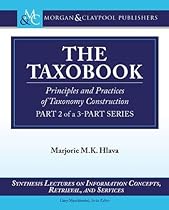The Taxobook: Principles and Practices of Building Taxonomies, Part 2 of a 3-Part Series (Synthesis Lectures on Information Concepts, Retrieval, and Sevices)

| Author | : | |
| Rating | : | 4.82 (656 Votes) |
| Asin | : | 1627055800 |
| Format Type | : | paperback |
| Number of Pages | : | 164 Pages |
| Publish Date | : | 2013-03-14 |
| Language | : | English |
DESCRIPTION:
Moving on to the central focus of this book, I introduce the basics of taxonomies, including a definition of vocabulary control and why it is so important, how indexing and tagging relate to taxonomies, a few of the types of tagging, and a definition and discussion of post- and pre-coordinate indexing. After that I present the concept of a hierarchical structure for vocabularies and discuss the differences among various kinds of controlled vocabularies, such as taxonomies, thesauri, authority files, and ontologies. After that, I present the steps required to build a taxonomy, from defining the focus, collecting and organizing terms, analyzing your vocabulary for even coverage over subject areas, filling in gaps, creating relationships between terms, and applying those terms to your content. This book outlines the basic principles of creation and maintenance of taxonomies and thesauri. I believe that it is important to understand the markup languages (SGML and XML specifically, and HTML to a lesser extent) in relation to information structure, and how taxonomies and metadata feed into that structure. Often, the first step is to get management and budgetary approval, so I start this book with a discussion of reasons to embark on the taxonomy journey. From there I mo
Issued in three parts, Taxobook is all about “creating Issued in three parts, Taxobook is all about “creating and maintaining taxonomies and their practical applications, especially in search functions.” In a manageable number of brief chapters, author Marjorie Hlava, founder and president of Access Innovations, Inc. (accessinn.com), is able to focus on the history and philosophical development of taxonomies (Part 1), the steps necessary to develop an effective taxonomy (Part 2), and using your taxonomies to maximize retrieval (Part 3).In Part 1, subtitled “History, Theories, and Concepts of Knowledge Organization,” Hlava traces the de. Coverage is too wide The author clearly knows a lot about the subject, but this book presentation is disappointing in several aspects. It is a short but expensive book -- I expected a very subjective presentation as a result, but feel there is a lot of filler in the book. The book totals 1Coverage is too wide M. Andrews The author clearly knows a lot about the subject, but this book presentation is disappointing in several aspects. It is a short but expensive book -- I expected a very subjective presentation as a result, but feel there is a lot of filler in the book. The book totals 140 pages. There are two pages devoted to the awards the author and her company have won at various points, and three pages of screenshots of her company's proprietary software, the kind of material I'd expect in a commercial white paper. There are many pages that quote directly from online sources such as Wikipedia, or quote extensively from. 0 pages. There are two pages devoted to the awards the author and her company have won at various points, and three pages of screenshots of her company's proprietary software, the kind of material I'd expect in a commercial white paper. There are many pages that quote directly from online sources such as Wikipedia, or quote extensively from
The Taxobooks
